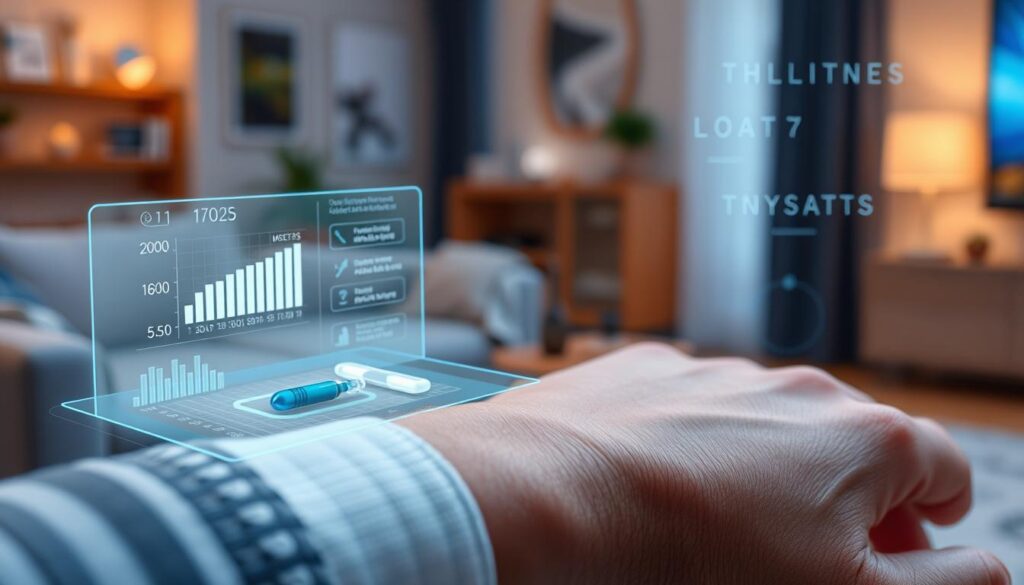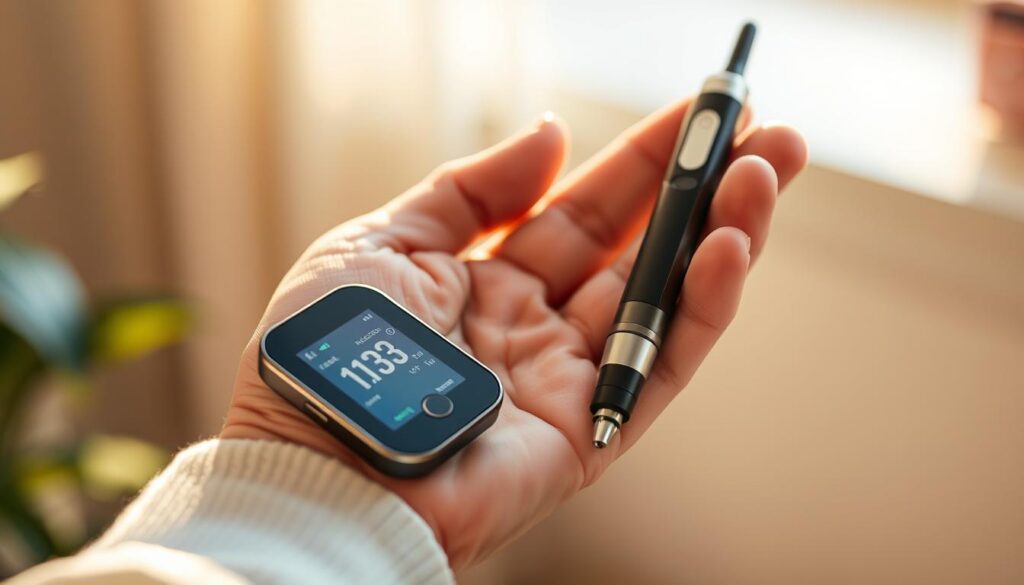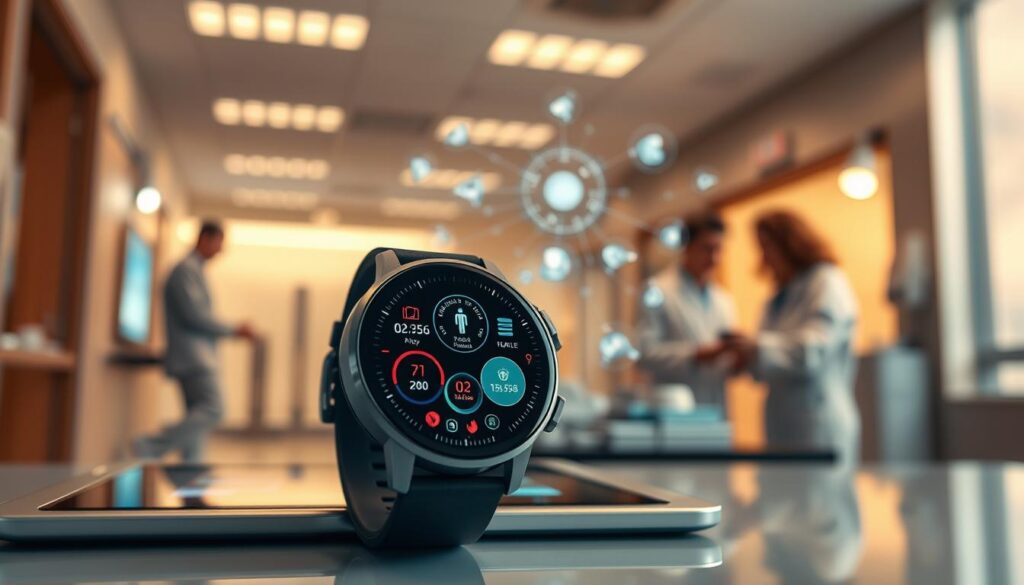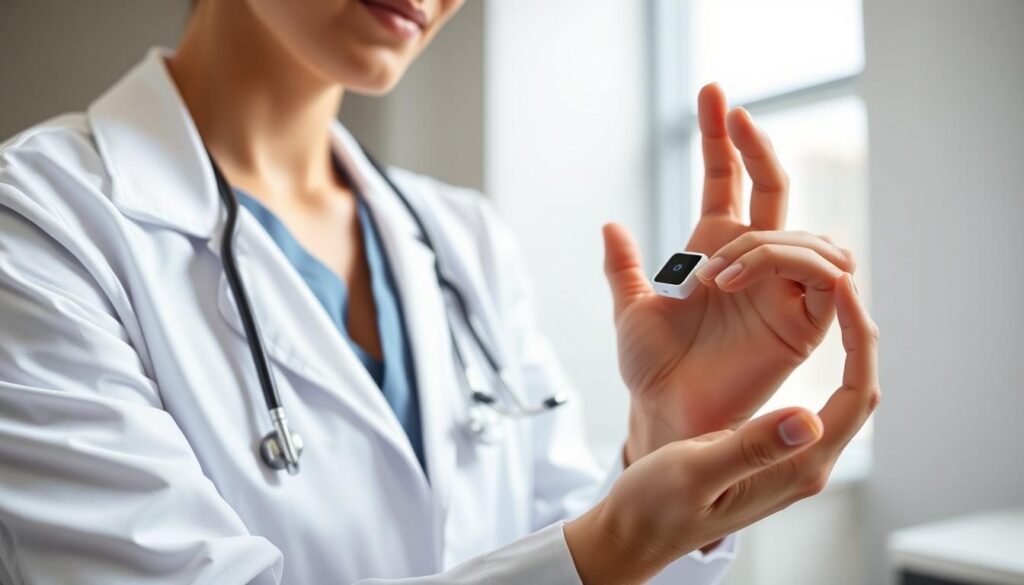When Sarah first started managing her condition, she carried a bulky notebook everywhere. Jotting down numbers, guessing patterns, and missing trends felt like a part-time job. Then, in 2025, she discovered tools that changed everything—small, sleek devices that whispered real-time updates to her phone, turning chaos into clarity.

Today’s health tech isn’t just about convenience—it’s about redefining what’s possible. Cutting-edge gadgets now track vital metrics automatically, from blood sugar fluctuations to heart rhythms. They sync with apps to create personalized reports, helping users spot patterns without endless manual logging.
These innovations do more than simplify routines. They bridge gaps between patients and care teams, offering instant data sharing and alerts. For many, this means fewer surprises and more confidence in daily choices. It’s not just a step forward—it’s a leap toward truly integrated care.
Key Takeaways
- 2025’s devices offer real-time health tracking without constant manual input
- Advanced sensors provide clearer insights into daily patterns and risks
- Seamless app integration helps users and doctors make faster decisions
- Automated alerts reduce guesswork in treatment adjustments
- New systems prioritize both physical metrics and long-term wellness goals
Overview of Diabetes Management Technology in 2025
The days of manual tracking and uncertain adjustments are fading fast. Today’s tools blend precision with simplicity, helping users stay ahead of health fluctuations. This shift marks a new era where prevention of any reaction, thanks to smarter data collection and analysis.

From Reactive to Predictive Care
Continuous tracking systems now replace routine finger pricks for many. These devices gather information 24/7, spotting trends that manual checks might miss. Advanced algorithms analyze patterns, offering tailored suggestions instead of generic advice.
“We’re not just treating numbers—we’re understanding lifestyles,”
—Dr. Elena Torres, Endocrinologist
Tools That Adapt to Real Life
Modern systems combine multiple health metrics into unified dashboards. Activity levels, meal timing, and medication data work together to paint complete pictures. This integration helps people make informed choices without overwhelming them.
| Feature | Traditional Approach | 2025 Technology |
|---|---|---|
| Data Updates | 4-7 daily checks | 288+ automatic readings |
| Trend Analysis | Weekly reviews | Real-time alerts |
| User Support | General guidelines | Personalized feedback |
These advancements remove barriers for those less tech-savvy. Simplified interfaces and voice-guided tutorials ensure everyone benefits equally. The result? More time living life, less time managing conditions.
Smart diabetes wearable, Bluetooth glucose meter, smart insulin pen
Modern health tools now work together like a well-trained team, silently coordinating care behind the scenes. Three innovations stand out for their precision and connectivity:

Cutting-Edge Features and Device Integration
The iHealth Gluco+ delivers lab-grade accuracy in five seconds, syncing results directly to phones. No more manual coding or delayed readings. Its FDA-cleared design simplifies testing for all ages.
| Device | Key Benefit | Integration |
|---|---|---|
| Guardian Connect | Predicts highs/lows 60 minutes early | Auto-shares data with care teams |
| InPen System | Tracks temperature & dosage | Links to meal-tracking apps |
Ensuring Accurate Glucose Monitoring & Insulin Dosing
Advanced sensors now cross-check data between devices. If a CGM detects rising levels, paired injection systems suggest adjusted doses. The InPen’s half-unit precision helps avoid overcorrection.
Temperature sensors in medication pens protect insulin effectiveness. Automatic reminders prevent missed doses, while encrypted apps keep records secure. As one user notes: “It’s like having a nurse in my pocket.”
Integration with Digital Health Ecosystems
The true power of modern health tools lies in their ability to connect. Devices, apps, and care teams now work as one unified digital support network. This integration turns scattered data points into actionable strategies.

Mobile App Connectivity and Real-Time Data
Smartphone applications act as mission control, pulling information from multiple sources. The InPen app, for example, combines continuous glucose monitor readings with meal logs and medication timestamps. It then calculates precise insulin needs in seconds.
These platforms automatically record every detail—no manual entry required. Historical trends become clear at a glance, helping users spot patterns. One nurse practitioner notes: “I finally see the full picture between visits.”
Seamless Communication with Healthcare Providers
Systems like CareLink let doctors access live updates through secure portals. They review glucose patterns, medication adherence, and lifestyle factors remotely. Adjustments happen faster when both sides share the same real-time data.
Patients report feeling more supported between appointments. Automated alerts flag concerning trends before they escalate. This proactive approach reduces emergencies and builds trust in daily management plans.
User Benefits, Safety, and Real-World Impact
Modern health tools create ripple effects beyond numbers on a screen. They reshape routines, build confidence, and help users reclaim time once lost to constant calculations.

Enhanced Safety Information and Compliance
Devices like the InPen require medical oversight for proper setup. Clinicians program dosage limits based on individual needs to prevent dangerous blood sugar swings. Those with vision challenges or difficulty testing levels manually should explore alternatives.
Key compliance factors include:
- Two daily checks minimum for systems like Guardian Connect
- Age-specific guidelines (14-75 years for most models)
- Regular device calibration per instructions
User Experiences and Personalized Diabetes Management
“My device catches trends I’d miss,” shares Mark, living with type 1 for 15 years. Advanced systems analyze sleep patterns, meals, and activity to suggest insulin adjustments. This tailored approach helps 78% of users maintain healthier levels with less effort.
| Management Aspect | Traditional Approach | 2025 Solutions |
|---|---|---|
| Needle Insertions | 5-7 daily | 93% reduction |
| Dose Accuracy | ±15% variance | Half-unit precision |
Reducing Daily Management Burdens
Automated tracking cuts decision fatigue. One parent notes: “I spend 20 fewer minutes daily prepping school supplies since alerts handle reminders.” Integrated ports maintain medication effectiveness while minimizing skin irritation from multiple injections.
These tools don’t eliminate care—they make it sustainable. By simplifying complex tasks, they help people focus on living rather than just managing their condition.
Conclusion
The future of health management has shifted from fragmented tracking to unified support. Advanced tools now combine real-time metrics with personalized guidance, creating systems that adapt to individual rhythms. This integration helps people focus less on numbers and more on living fully.
Modern technology bridges gaps between daily habits and medical needs. Precise dosing suggestions and pattern alerts reduce guesswork while maintaining safety. Clinicians gain clearer insights through shared data streams, enabling faster adjustments during remote consultations.
Choosing the right device combination requires professional guidance. Factors like activity levels, age, and lifestyle determine which systems deliver optimal results. Many insurance plans now cover these innovations, making advanced care more accessible.
As healthcare evolves, these solutions will grow smarter through AI analysis and predictive features. The goal remains constant: empowering individuals to manage conditions confidently while reclaiming time for what matters most in life.
FAQ
How do these devices connect to smartphones or apps?
Most modern tools use Bluetooth or Wi-Fi to sync with mobile apps, allowing real-time tracking of blood sugar trends and insulin doses. Apps like Dexcom Clarity or mySugr automatically update data for easy access.
Are continuous glucose monitors (CGMs) more accurate than fingerstick tests?
CGMs like the Freestyle Libre 3 provide near-instant readings with lab-grade precision, reducing the need for fingersticks. However, periodic calibration with a traditional meter is still recommended for optimal reliability.
Can healthcare providers access my data remotely?
Yes. Systems like Tidepool Loop securely share trends and dosing history with care teams through encrypted platforms, enabling timely adjustments to treatment plans without in-person visits.
What safety features prevent incorrect insulin doses?
Pens like the NovoPen 6 include dose calculators, memory logs, and alerts for potential errors. Always review the Important Safety Information and follow your prescribed regimen.
How do these tools reduce daily stress for type 1 patients?
Automated alerts for high/low levels, dose reminders, and trend analysis minimize guesswork. Integrated systems cut manual steps, letting users focus on daily life rather than constant monitoring.
Can multiple devices work together seamlessly?
Many products now support interoperability. For example, the Omnipod 5 insulin pump adjusts delivery based on Dexcom CGM readings, creating a hybrid closed-loop system for smoother management.
Transform Your IoT Vision Into Reality.
Get free expert insights, architectures & cost breakdowns.
Drop your email to schedule free meeting.